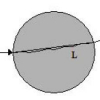Free Online Productivity Tools
i2Speak
i2Symbol
i2OCR
iTex2Img
iWeb2Print
iWeb2Shot
i2Type
iPdf2Split
iPdf2Merge
i2Bopomofo
i2Arabic
i2Style
i2Image
i2PDF
iLatex2Rtf
Sci2ools
ISBI
2004
IEEE
2004
IEEE
Nanoparticle-Enhanced Proton Computed Tomography: A Monte Carlo Simulation Study
Proton computed tomography (pCT) has the potential to improve the accuracy of proton treatment planning, which is currently based on x-ray computed tomography (xCT). However, at this time no method exists for pCT to selectively increase the contrast of tumor tissues with respect to normal tissues. One possibility to achieve this goal is to bind gold-nanoparticles, i.e., microscopic structures in the size range of 1 nm to several hundred nanometers, to the surface of tumor cells with cellseeking antibodies conjugated to the surface of the nanoparticles. In order to test the suitability of this approach, we used the Monte Carlo transport code GEANT4, to provide simulated histories of 200 MeV protons going through a cylindrical water phantom with embedded inhomongenities enhanced with traces of gold. The energy loss of several million protons traversing the cylinder from 180 different angles formed the basis for reconstructing the a single proton CT image representing the relative volume...
ISBI 2004 | Medical Imaging | Proton Computed Tomography | Single Proton Ct | X-ray Computed Tomography |
| Added | 20 Nov 2009 |
| Updated | 20 Nov 2009 |
| Type | Conference |
| Year | 2004 |
| Where | ISBI |
| Authors | Reinhard Schulte, Vladimir Bashkirov, David Williams, Hartmut Sadrozinski, Tianfang Li, Zhengrong Liang, Steven Peggs, Todd Satogata |
Comments (0)

